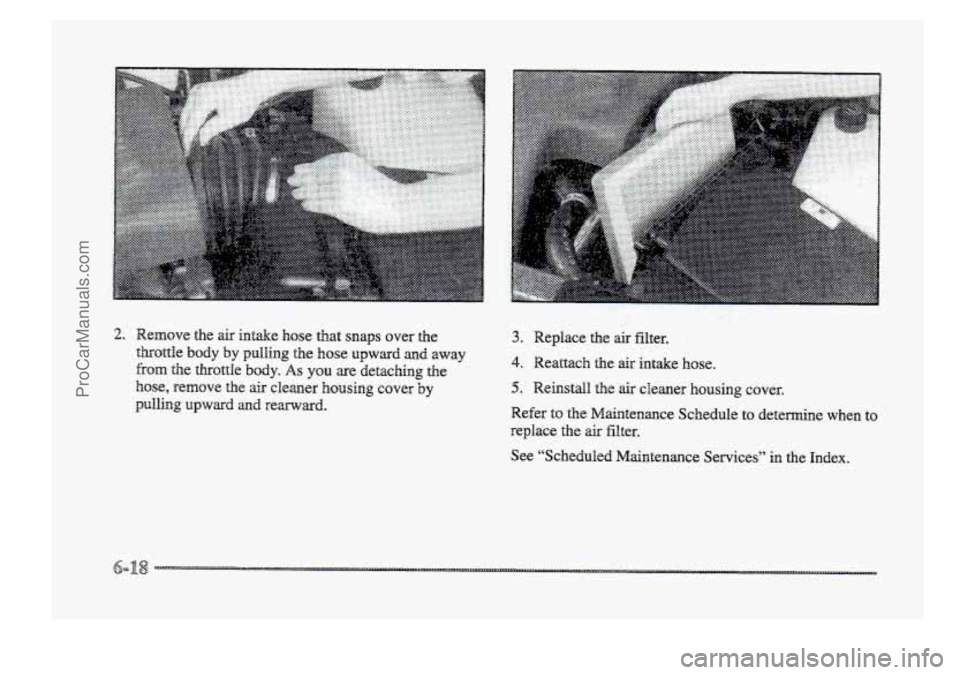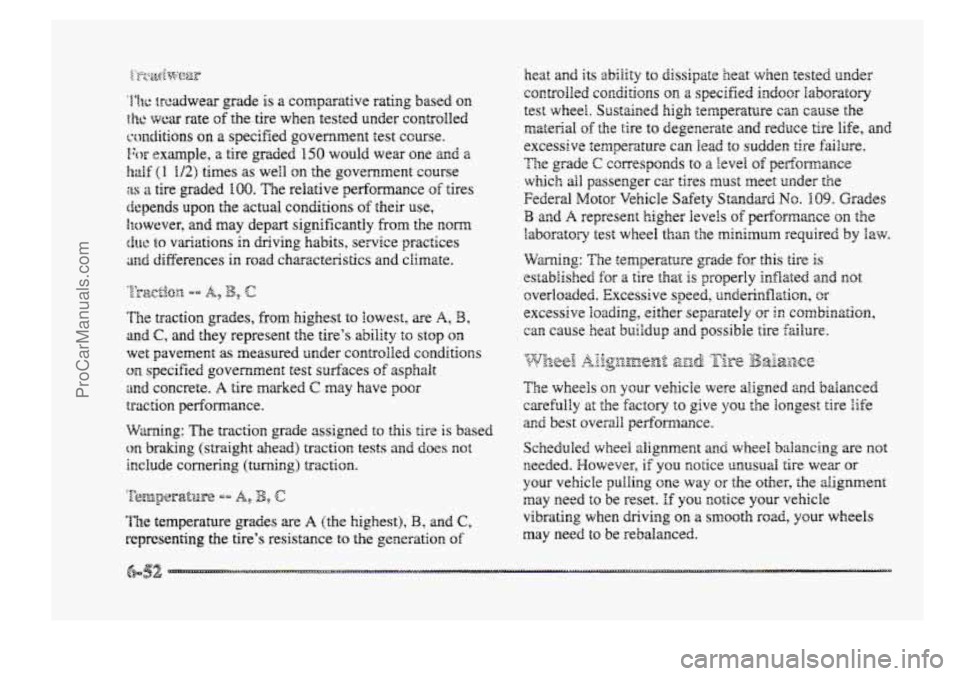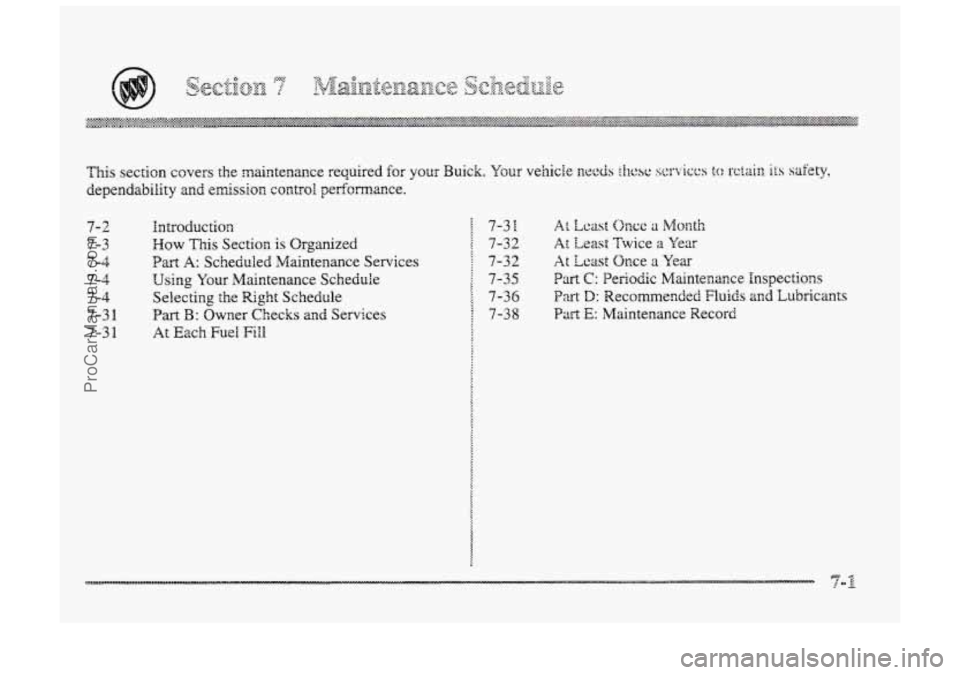1998 BUICK PARK AVENUE service schedule
[x] Cancel search: service schedulePage 290 of 426

If none of them is true, use the %ong triphighway
maintenance schedule. Change the oil and filter every
7,500 miles (12 500 km) or 12 months -- whichever
occurs
ht. Driving a vehicle with a fully warmed
engine
under highway conditions causes engine oil
to $re& down dower.
If any one of these is true for you, use the short tripkity
maintenance schedule:
8
Most trips are less than 5 to 13 miles (8 to I 6 km).
This is particularly important when outside
temperatures
are below freezing.
Most trips include extensive id1ir.g (such as frequent
$riving
in stop-and-go traffic).
Most
trips are though dusty areas.
You frequently tow a trailer or use a carrier on top of
your vehicle.
The vehicle is used for delivery service, police, taxi
or other
commercial application.
Driving under these conditions causes engine
oil to
break down
sooner. Hf any me of these is true for your
vehicle, then
YOU need to change your si1 and filter
every
3,000 miles (5 000 km) or 3 months -- whichever
occurs
kt. (See Engine Oil Life Monitor (Index) in
the Index.
1
Did you know that used engine oil contains certain
ekmer,ts that may
be unhealthy for your skin and csdd
even cause cancer? Don’t let used oil stay on your skin
for very iong. Clean your skin and nails with soap and
water, or a good hznd cleaner. Wash or properly throw
away clothing or rags containing used engine oil. (See
the manufacturer’s warnings about
the use and disposal
of oil products.)
Used oil can be a real t-heat to the environment. If you
change
your own oil, be sure to drain all free-flowing
oil
from the filter before disposal. Don’t ever dispose of
oil by putting it in the trash, pouring it on the ground,
into sewers, or into streams or bodies of water. Instead,
recycle it by taking it
to a place that coilects used oil. If
you have a problem properly disposing of your used oil,
ask your dealer,
a service station or a local recycling
center for kelp.
ProCarManuals.com
Page 292 of 426

... .. .. ..
2. Remove the air intake hose that snaps over the
bottle
body by pulling the hose upward and away
from the throttle body. As YOU are detaching the
hose, remove ahe air cleaner housing cover by
pulling upward and remarc%.
3. Replace the air filter.
4. Reattach the air intake hose.
5. Reinstall the air cleaner housing cover.
Refer
to the Maintenance Schedule to determine when to
replace the
air filter.
See “Scheduled Maintenance Services” in the Index.
ProCarManuals.com
Page 294 of 426

Check oil only when the engine is cold. Allow the
engine
to cool two to three hours after running.
I. Clean tke area around the oil fill plug before
removing it.
2. Remove the G~H fill plug wing a 3/26 inch
Allen
wrench.
3. The oil level is correct when it just reaches efre
bottom of the threads of the inspection hole.
4. Replace the oil plug with the O-ring in place.
Torque
to 88 bin ( IO N-m).
A good time to check your automatic transaxle fluid
level is wherr the engine oil is changed.
Change
both the fluid a.nd filter every 50,000 miles
(83 080 Ian) if the vehicle is mainly driven rander one
or more of these conditions:
8 In heavy city traffic where the outside temperature
regularly reaches
90°F (32°C) or higher.
0 Uses such as found in taxi, police QT delivery service.
If you do not use your vehicle under any sf these
conditions, the fluid and filter do not reqwie changing.
See “Scheduled Maintenance Services” in the Index.
ProCarManuals.com
Page 326 of 426

''I+he brcadwear grade is a comparative rating based Q~Z
t tze wcx rate of the tire when tested under controlled
conditions
on a specified government test course.
For example, a tire graded 150 would wear one md a
Mf (I U2) times as well on the government course
:H tire graded 100. The relative performance of tires
depends
upon the actual conditions of their use,
however, and may depart significantly from the norm
tErrc to variations in driving habits, service practices
and differences in road characteristics and climate.
'The traction grades, from highest
to !owest, are A, 3,
and C, and they represent the tire's ability to stop ora
wet pavement as measured mder controlled conditions
on specified government test surfaces of asphalt
2nd concrete. A tire marked &: may have poor
traction performance.
Warning: The traction grade assigned
to this tire is based
on
braking (straight alead) traction tests and does not
ifgcllude cornering (turning) traction. heat
and its ability to dissipate heat when tested under
controlled csndidsns on a specified indoor laboratory
test wheel. Sustained
high temperature can cause the
material of the tire to degenerate and reduce tire life, and
excessive ternperaFure can lead to sudden fire faifwe.
The grade C corresponds to a level of pedomance
which ail passenger cx tires must meet e~nder the
Federal
Motor Vehicle Safety Stmda-d No. i09. Grades
B asci A represent higher levels of perhmance an the
laboratory test wheel than the minimum required by law.
The wheels OR your vehicle were aligned and balanced
careEulIy at the factory to give you the longest tire life
acd best overall performance.
Scheduled wheel alignment
and wheel balancing are not
needed. However, if you notice unusual tire wear or
your vehicle pulling GR~ way OF the other, the akignment
may need
to be reset. If YOU notice your vehicle
vibrating
when driving on a smooth road, your wheels
may need
to be rebalaaaced.
ProCarManuals.com
Page 351 of 426

7- 2
7-3
7-4
7-4 7-4
7-3 1
7-3 1
Introduction
How
This Section is Organized
Bart A: Scheduled Maintenance Services
Using Your Maintenance Schedule
Selecting the Right Schedule
Part B: Owner Checks and Services
At Each Fuei Fill
At Least oncc a h4onth
At Least Twice a Year
At Least Once a Year
Part C: Periodic Maintenance hspections
Part D: Recommended Fluids and Lubricants
Part E: Maintenance Record
ProCarManuals.com
Page 353 of 426

._y 0 C. 12‘3\+7 p &-2cbisn Tq LL
The remainder of this section is divided into five pms:
”Part A: Scheduled Maintenance Services” shows
what to have done and how oftec. Some of these
services
can be complex, so unless you are technically
qualified and have the necessary equipnent, you should
let your dealer’s service department
or another qualified
service center
do these jobs.
Performing maintenance work on a vehicle can
be dangerous.
In trying to do some Jobs, you can
be seriously injured.
Do your own maintenance
work O~Y if you have the required know-how
and the proper tools and equipment for the job.
If you have any doubt, have a qualified
technician
do the work.
If you are skilled enough to do some work on your
vehicle, you will probably want
to get the service
information. See “Service and Owner Publications”
in the Index.
“Part 8: Owner Cheeks and Services” tells you
what should be checked and when.
It also explains
what YOU can easily do to help keep your vehicle in
good condition.
“Part C: Periodic Maintenance Inspections”
explains important inspections that your deater’s
service department or another quaiifled service center
should perfom.
“Part D: Recommended Fluids and Llph~ricipn~’’
lists some recommended products to hcBp keep your
vehicle properly
maintained. T’kzesc 19n~lucts, or their
equivalents, should
be used wlacikct. you do the work
yourself or have
it done.
“Past E: Maintenance Record’’ provides a,place for
you to record the ~naintcrrance performed on your
vehicle. Whenever any n:aintcnancc is performed, be
sure to write it down in Ffris part. ’his will help you
determine when your next nraintenance should be done.
In addition,
it is ;L good idca to keep your maintenance
receipts.
They may be rleedcd to qualify your vehicle
for warranty repairs.
ProCarManuals.com
Page 354 of 426

We at General Motors want to kelp you keep your
vehicle
ia good working condition. But we don’t
know exactly
how you’ll drive it. You may drive very
short distances only
a few times a week. Or you may
drive long distances
aEB the time in very hot, dusty
weather.
You may use your vehicle in making deliveries.
Or
YOU may drive it to work, to do errands or in
many other ways.
Because of all thc different ways people use their
vehicles, maintenance
rreeds vary. You may even
need
more frequent checks and repiacements than
you’ll
find in the schedules in this section. So please
read this section
and note how you drive. If you have
any questions on how to keep your vehicle in
good
condition, see your Buick dealer.
This part tells
you the maintenance services you should
have done and when you should schedule them. If you
go to your dealer for your service needs, you’ll know
that GM-trained and supported service people will
perform the work
using genuine GM parts. The
proper fluids and
lubricants to use are listed in
Part D. Make sure whoever services your vehicle
uses these. All
parts should be replaced and a1
necessary repairs done before you
or anyone else
drives the vehicle.
These schedules
are for vehicles that:
cany passengers and cargo within recommended
limits.
You will find these limits on your vehicle’s
Tire-Loading Information label. See “Loading Your
Vehicle”
in the Index.
are driven on reasonable road surfaces within legal
use the recommended fuei. See “Fuel” in the Index.
driving
limits.
First you’ll need to decide which
of the two schedules is
right for your vehicle. Here’s how to decide which
schedule
to follow:
ProCarManuals.com
Page 355 of 426

i ~~
Follow the Short Trip/City Maintenance Schedule if any
one of these conditions
is true for your vehicle:
0
0
0
0
0
Most trips are less than 5 to 10 miles (8 to I6 km).
This is particularly important when outside
temperatures are below freezing.
Most
trips include extensive idling (such as frequent
driving
in stop-and-go traffic).
Most trips are through dusty areas.
You frequently tow a trailer or use a carrier on tog of
your vehicle.
If the vehicle
is used for delivery service, police, taxi
or other commercial application.
One of the reasons you should follow this schedule
if you operate your vehicle under any of these conditions
is that these conditions cause engine oil to break
down
soonep:
r---
ShQTt 7&+p/cigy &$-~~y& c .. 6 - I-
Every 3,000 Miles (5 000 km): Engine Oil md Filter
Every 6,000 Miles (10 000 km): Chassis Lubrication
Every 12,000 Miles (20 000 km): Passenger
Every 15,000 Miles (25 000 km): Air Cleaner Filter
Every 30,000 Miles (50 000 km): Air Cleaner Filter
Change (or
3 months, whichever
occurs first).
(or
6 mo-nth, whichever occurs first). Tire Rotation.
Compartment Air Filter Replacement.
Inspection,
if driving in dusty conditions.
Replacement. Fuel
Tank, Cap and Lines Inspection.
Supercharger
Oil Check (or every 36 months,
whichever occurs first)
(3.8L Code I engine only).
Every 50,000 Miles (83 080 km): Automatic Transaxle
Service (severe conditions only).
Every 60,000 Miles (100 000 km): Engine Accessory
Drive Belt Inspection.
Every 100,000 Miles (166 000 km): Spark Plug Wire
Inspection.
Spark Plug Replacement.
Every 150,000 Miles (240 000 km): Cooling System
Service
(or every 60 months, whichever occurs first).
These intervals only summarize maintenance services.
Be sure to follow the complete maintenance schedule on
the following pages.
RP I -3
ProCarManuals.com